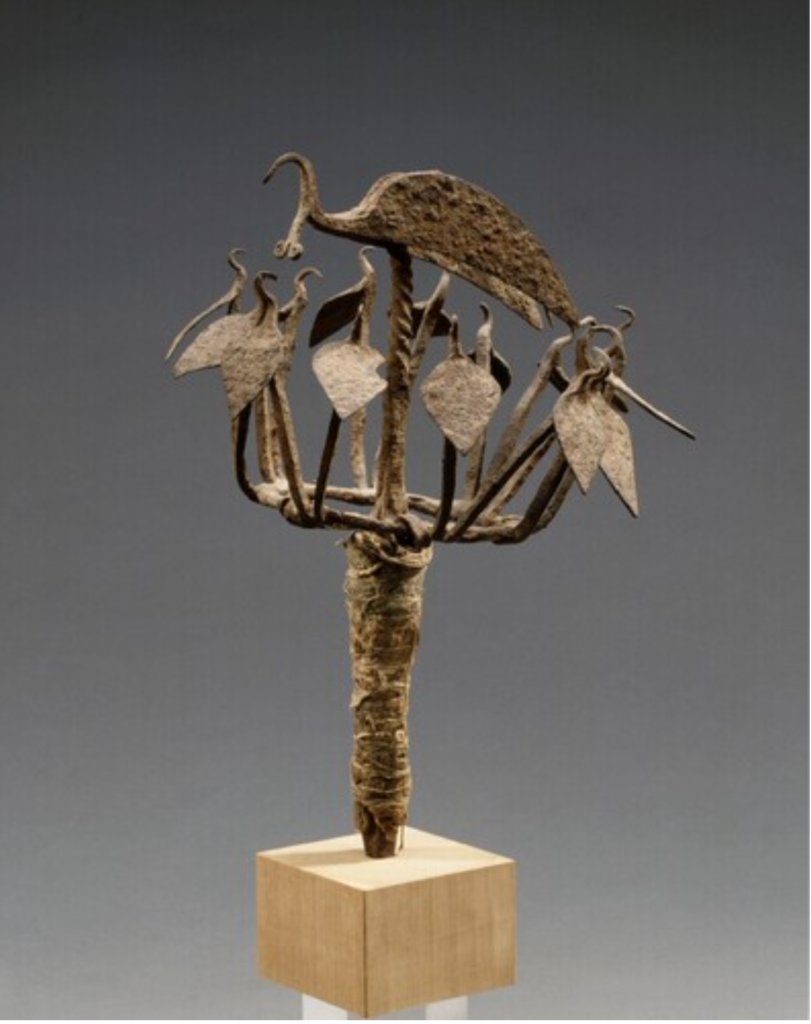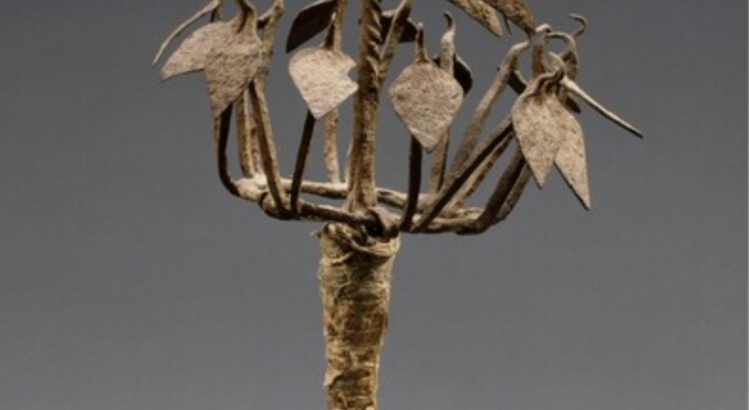If there is anything us humans can learn from the Covid-19 pandemic, it is that our daily lives are influenced significantly by nature and external factors that we can’t control. Although modern or ‘Western’ medicine helps us battling numerous diseases, sometimes finding a cure isn’t that easy or even impossible. Many cultures around the world have a different outlook on sickness and health, and are more aware of the way human and nature are intertwined. The Tropenmuseum’s new exhibition Healing Power sheds light on several of these cultures and their traditions in treatment of physical and mental diseases.
While looking at the collection of the exhibition Healing Power, one is struck by all the objects from different cultures and their role in treating illness and disease. One object that catches the eye is the Osanyin staff (Opa Osanyin): a big wrought iron staff topped with sixteen birds surrounding one big bird in the center. It has a height of 32 centimeters and is finished with a textile element around the bottom. Healing Power is not the first Dutch exhibition that displays this Osanyin staff, as it was part of the exhibition Style and Tradition in the Yoruba Art at the Africa Museum in 2004. The Osanyin staff is originally part of the religion of the Yoruba people: an ethnic group that inhabits western Africa, mainly Nigeria. This group consists of approximately 40 million people, making it one of Africa’s largest ethnic populations. A significant proportion of the Yoruba people were dispersed around the world due to the slave trade and later migration flows, causing several contemporary Yoruba people to convert to Christianity or the Islam. However, many principles of the traditional faith are still being upheld today by groups of the Yoruba people living in Africa. There is a Yoruba online blog devoted to their stories and journeys.

In the Yoruba culture and religion, spirits (Orisha) that are sent by the supreme creator (Olodumare) play a crucial role. It is thought that they are on earth with the mission to help and guide humanity. The spirit Osanyin helps the Osanyin priests and herbalists in curing mental and physical illnesses, caused by evil malevolent spirits, such as witches that hide in the woods. The staff plays a crucial role in this process. When we look at the staff, we see the composition of a circle of sixteen small birds and a shaft that elevates a large bird above the smaller ones. Nigerian art historian Babatunde Lawal explained this division by stating that the Yoruba people refer to Osanyin as ‘the one who sees everything’. Therefore, the staff gives him a point high off the ground, from which he can protect all humans on earth. The sixteen small birds invoke the most sacred number of divinations in the Yoruba tradition and are a returning aspect in ceremonial and divine objects, such as royal crowns.
To this day, the meaning of the bird in the middle is still today open for debate; some say it represent Osanyins older brother Orunmila instead of Osanyin himself. However, no one argues about the meaning of the sixteen smaller birds. The Yoruba people believe that they represent witches and other evil spirits that can change into birds at night. It might seem a little weird that the priests would put their enemies upon a staff that is supposed to protect them. However, in the iconography of the Yoruba people, these birds do not only represent the threats in nature. The spirits they embody are also part of the solution to mental and physical illnesses. The priests can convince the spirits to use their powers for good instead of evil by understanding them and gaining control over them, rather than fighting them. The spirits will then help the priests to cure their patients. Maybe when visiting the exhibition in the Tropenmuseum, we can ask Osanyin for help in convincing our own evil spirits to help us instead?
In the iconography of the Yoruba people, these birds don’t only represent the threats in nature. The spirits they embody are also part of the solution to mental and physical illnesses.
Establishing the fact that the Osanyin staff is part of a living culture, we might wonder how this exemplar ended up in the Tropenmuseum’s exhibition Healing Power in The Netherlands. This is clarified by the fact that the Tropenmuseum is part of a larger organization named Nationaal Museum van Wereldculturen (National Museum of World Cultures). Many of the artifacts that are in possession of this organization are on loan from the Congregatie van de Heilige Geest (Congregation of the Holy Spirit). Throughout history this group of missionaries was active in different parts of the world, among which Africa. From 1954 onwards, they collected artifacts from across the globe to learn more about the different cultures they encountered. Although the exact date is not documented, this Osanyin staff is part of their elaborate collection and must have been acquired before 1984. Considering the ways numerous of these objects were taken from their home country; it remains an ethical conundrum if they should be returned to where they came from. The debates around the restitution of these objects have had some media attention in Dutch newspapers, such as het Parool, over the past few years.

Do you want to know more about the culture and religion of the Yoruba people? Of course you want to! Check out the following link to buy your tickets for the exhibition Healing Power or read the recently published book The Yoruba: A new History by the African archeologist and historian Akinwumi Ogundiran.
By Annabel van Amerongen
